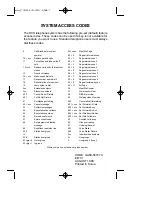
301
Mai
l
■
Dates
●
Numbers separated by a slash (/) or period (.) are read out as dates. If “M”, “T”, “S” or “H” (upper case) is inserted
before a date, the corresponding (Japanese) era name is read out.
・
The above formats for numbers, monetary amounts, phone numbers, times and dates can also be used with full-pitch
characters.
・
When monetary amounts, phone numbers, times or dates are read out, if the string read out is immediately preceded
or followed by any of the characters shown below, the numbers will not be delimited correctly when read out. When
you want to have monetary amounts, phone numbers, times or dates read out, you should use a space as the
delimiting character before and after the item.
0-9, A-Z (upper case), colon (:), ¥, slash (/), period (.), hyphen (-) (half-pitch or full-pitch)
■
Symbols
●
The FOMA terminal can read out the symbols shown below. (These symbols are read out as shown when used with
numbers.)
■
Other
●
Alphabetic letters are read out as such, but may be read otherwise in certain combinations.
●
Depending on the content of a sentence or description (particularly where place names or proper nouns are used),
the FOMA terminal may not read out the sentence or may read it out incorrectly.
●
Mail is not read out in a natural voice. In some cases the sounds or stress may be difficult to understand.
●
Items such as punctuation marks (periods and commas), line feeds and spaces serve as separators for passages
read out, except where a period (.) or comma (,) is preceded and/or followed by numbers. In text that has no delimiting
punctuation, reading is automatically paused.
Depending on the content being read out, there may be a pause before the FOMA terminal starts speaking. The
FOMA terminal may also be unable to correctly read out passages where kanji characters are used. To ensure that
the content of your received mail is read out correctly, you should recommend the following guidelines to people with
whom you frequently correspond:
・
Compose your e-mail using katakana for nouns, particularly proper nouns such as place names and personal
names.
・
Use punctuation marks when composing e-mail.
PM “Hour”:”Minute” or “Hour”:”Minute” PM (”Hour” = 0-12; “Minute” = 00-59)
e.g. 5:05PM
→
“Gogo goji gofun”
“Year”/”Month”/”Day” or “Year”.”Month”.”Day” (”Year” = 0-9999; “Month” = 1-12; “Day” = 1-31)
“M” “Year”/”Month”/”Day” or M” “Year”.”Month”.”Day” (”Year” = 0-99; “Month” = 1-12; “Day” = 1-31)
e.g. M10/04/20
→
“Meiji junen shigatsu hatsuka”
“T” “Year”/”Month”/”Day” or “T” “Year”.”Month”.”Day” (”Year” = 0-99; “Month” = 1-12; “Day” = 1-31)
e.g. T8.10.15
→
“Taishou hachinen jugatsu jugonichi”
“S” “Year”/”Month”/”Day” or “S” “Year”.”Month”.”Day” (”Year” = 0-99; “Month” = 1-12; “Day” = 1-31)
e.g. S50.3.6
→
“Shouwa gojunen sangatsu muika”
“H” “Year”/”Month”/”Day” or “H” “Year”.”Month”.”Day” (”Year” = 0-99; “Month” = 1-12; “Day” = 1-31)
e.g. H15.7.24
→
“Heisei jugonen shichigatsu nijuyokka”
$
(dollars)
→
doru
%
(percent)
→
paasento
¥
(yen)
→
en
°
(degrees)
→
do
°C
(degrees)
→
do
¥
(yen)
→
en
$
(dollars)
→
doru
%
(percent)
→
paasento
(mm)
→
miri
(kilograms)
→
kiro
(cm)
→
senchi
(meters)
→
meetoru
(grams)
→
guramu
(tons)
→
ton
(ares)
→
aaru
(hectares)
→
hekutaaru
(ml)
→
rittoru
(watts)
→
watto
(calories)
→
karorii
(dollars)
→
doru
(cent)
→
sento
(percent)
→
paasento
(millibars)
→
miribaaru
(pages)
→
peeji
mm (millimeters)
→
mirimeetoru
cm (centimeters)
→
senchimeetoru
km (kilometers)
→
kiromeetoru
mg (milligrams)
→
miriguramu
kg
(kilograms)
→
kiroguramu
cc
(cubic centimeters)
→
siisii
m
2
(square meters)
→
heihoumeetoru
e.g. 2004/5/5
2004/05/05
2004.5.5
2004.05.05
“Nisen’ yonen gogatsu itsuka”
Summary of Contents for FOMA N700?
Page 77: ......
Page 115: ......
Page 241: ......
Page 321: ......
Page 581: ......
Page 582: ...Index Quick Manual...
Page 588: ...585 Index Quick Manual Memo...
Page 589: ...586 Index Quick Manual Memo...
Page 590: ...587 Index Quick Manual Memo...
















































